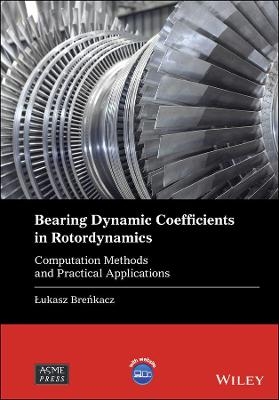
Bearing Dynamic Coefficients in Rotordynamics
Wiley-ASME Press (Verlag)
978-1-119-75926-3 (ISBN)
Bearing Dynamic Coefficients in Rotordynamics delivers an authoritative guide to the fundamentals of bearing and bearing dynamic coefficients containing various computation methods. Three of the most popular and state-of-the-art methods of determining coefficients are discussed in detail. The computation methods covered include an experimental linear method created by the author, and numerical linear and nonlinear methods using the finite element method. The author—a renowned expert on the topic—presents the results and discusses the limitations of the various methods.
Accessibly written, the book provides a clear analysis of the fundamental phenomena in rotor dynamics and includes many illustrations from numerical analysis and the results of the experimental research. Filled with practical examples, the book also includes a companion website hosting code used to calculate the dynamic coefficients of journal bearings. This important book:
Covers examples of different computation methods, presents results, and discusses limitations of each
Reviews the fundamentals of bearing and bearing dynamic coefficients
Includes illustrations from the numerical analysis and results of the experimental research
Offers myriad practical examples and a companion website
Written for researchers and practitioners working in rotordynamics, Bearing Dynamic Coefficients in Rotordynamics will also earn a place in the libraries of graduate students in mechanical and aerospace engineering who seek a comprehensive treatment of the foundations of this subject.
Łukasz Breńkacz is an Assistant Professor and Research Associate at the Institute of Fluid Flow Machinery, Polish Academy of Sciences in Gdańsk, Poland. His research foci are on machinery design, the analysis of bearing systems, computer simulations, and experimental diagnostics of rotating machinery.
List of Figures x
List of Tables xvi
Preface xvii
Symbols and Abbreviations xix
About the Companion Website xxi
1 Introduction 1
1.1 Current State of Knowledge 1
1.2 Review of the Literature on Numerical Determination of Dynamic Coefficients of Bearings 6
1.3 Review of the Literature on Experimental Determination of Dynamic Coefficients of Bearings 7
1.4 Purpose and Scope of the Work 10
2 Practical Applications of Bearing Dynamic Coefficients 14
2.1 Single Degree of Freedom System Oscillations 16
2.1.1 Constant excitation Force 18
2.1.2 Excitation by Unbalance 20
2.1.3 Impact of Damping and Stiffness 24
2.2 Oscillation of Mass with Two Degrees of Freedom 26
2.3 Cross-Coupled Stiffness and Damping Coefficients 28
2.4 Summary 33
3 Characteristics of the Research Subject 34
3.1 Basic Technical Data of the Laboratory Test Rig 34
3.2 Analysis of Rotor Dynamics 36
3.3 Analysis of the Supporting Structure 42
3.4 Summary 44
4 Research Tools 46
4.1 Test Equipment 46
4.2 Test.Lab Software 49
4.3 Samcef Rotors Software 51
4.4 Matlab Software 51
4.5 MESWIR Series Software (KINWIR, LDW, NLDW) 52
4.6 Abaqus Software 53
5 Algorithms for the Experimental Determination of Dynamic Coefficients of Bearings 55
5.1 Development of the Calculation Algorithm 55
5.2 Verification of the Calculation Algorithm on the Basis of a Numerical Model 58
5.3 Results of Calculations of Dynamic Coefficients of Bearings 62
5.4 Summary 64
6 Inclusion of the Impact of an Unbalanced Rotor 65
6.1 Calculation Scheme 65
6.2 Definition of the Scope of Identification 67
6.3 Results of the Calculation of Dynamic Coefficients of Bearings Including Rotor Unbalance 68
6.4 Summary 69
7 Sensitivity Analysis of the Experimental Method of Determining Dynamic Coefficients of Bearings 70
7.1 Method of Carrying Out a Sensitivity Analysis 70
7.2 Description of the Reference Model 71
7.3 Influence of the Stiffness of the Rotor Material 71
7.4 Influence of Uneven Force Distribution on Two Bearings 72
7.5 Changing the Direction of the Excitation Force and its Effect on the Results Obtained 75
7.6 Eddy Current Sensor Displacement Impact Assessment 76
7.7 Calculation Results for an Asymmetrical Rotor 77
7.8 Summary 79
8 Experimental Studies 81
8.1 Software Used for Processing of Signals from Experimental Research 82
8.2 Software Used for Calculations of Dynamic Coefficients of Bearings 83
8.3 Preparation of Experimental Tests 85
8.4 Implementation of Experimental Research 87
8.5 Processing of the Signal Measured During Experimental Tests 91
8.6 Results of Calculations of Dynamic Coefficients of Hydrodynamic Bearings on the Basis of Experimental Research 93
8.7 Verification of Results Obtained 98
8.8 Summary 100
9 Numerical Calculations of Bearing Dynamic Coefficients 102
9.1 Method of Calculating Dynamic Coefficients of Bearings 102
9.2 Calculation of Dynamic Coefficients of Bearings Using a Method with Linear Calculation Algorithm 107
9.3 Calculation of Dynamic Coefficients of Bearings Using a Method with Non-linear Calculation Algorithm 113
9.4 Verification of Results Obtained 119
9.5 Summary 123
10 Comparison of Bearing Dynamic Coefficients Calculated with Different Methods 125
11 Summary and Conclusions 129
Appendix A 134
Appendix B 145
Appendix C 152
Research Funding 155
References 156
Index 163
| Erscheinungsdatum | 04.05.2021 |
|---|---|
| Reihe/Serie | Wiley-ASME Press Series |
| Sprache | englisch |
| Maße | 170 x 249 mm |
| Gewicht | 499 g |
| Themenwelt | Naturwissenschaften ► Physik / Astronomie ► Mechanik |
| Technik ► Maschinenbau | |
| ISBN-10 | 1-119-75926-9 / 1119759269 |
| ISBN-13 | 978-1-119-75926-3 / 9781119759263 |
| Zustand | Neuware |
| Haben Sie eine Frage zum Produkt? |
aus dem Bereich


